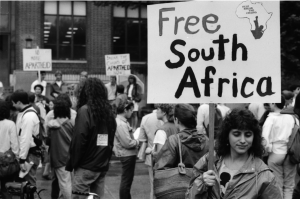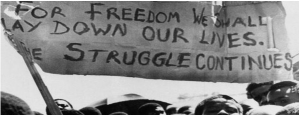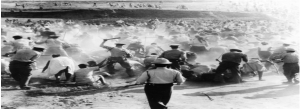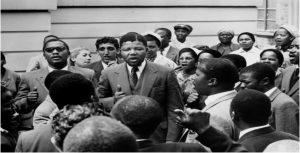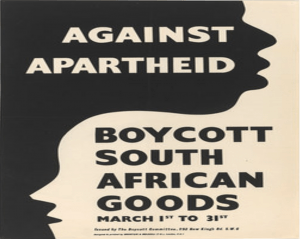An era of brutality
Written and edited by Julian Strohbecke
Despite being known as one of the more joyful members of staff, Catherine Jones grew up in and experienced the most brutal period in South African history. Consequently, she became an advocate for social justice in a nation polluted with racial inequality.
Catherine Jones was born in England where she was raised by conservative parents and led a relatively peaceful, upper-middle-class life where she was unaware of racism and segregation. Unfortunately, that all changed when she was 10 years old and her father’s work life brought the whole family to South Africa which was experiencing one of the most notorious periods in their history known as Apartheid.
A sign outside a Cape town Beach labelling the beach as a “white-only” area
Apartheid, meaning “separateness” in Afrikaans, was an age of racial segregation, oppression, censorship, and violence. During this period, non-whites such as Blacks, Indians and Asians were considered inferior and the nation was governed by Nationalist Afrikaners (descendants of Dutch settlers) who promoted white supremacy.
According to The Economist, around 50,000 children died every year during apartheid from the effects of malnutrition, while South Africa exported over $1 billion worth of food annually. During Apartheid, the Infant mortality rate for Black children was 282 per 1000 (due to poor sanitation, healthcare, and living conditions) while among whites it was 12 per 1000. From 1960 to 1965, an estimated 3.5 million Black South Africans were forcibly evicted from their homes by the government and relocated to barren, unsanitary tribal reserves known as “Homelands”.
Despite being caught in the middle of such a violent era, Catherine was relatively safe and far from the danger since she resided in an all-white community. She also attended an all-white girls school where the education system was heavily controlled by the government to ensure that students weren’t educated about the racial segregation and kept as docile as possible.
At first, she was not aware of the brutality that occurs outside the walls of her gated community. But her first taste of reality occurred in school when her history teacher broke the rules and openly ridiculed the government because of their racist ideologies. This consequently opened Catherine’s eyes to the real South Africa, a nation brimming with racial segregation.
A visit to a Black only school shocked her even more as she witnessed the horrendous conditions in which Black children have to learn. Each classroom contained 90 students (as compared to 17 in her school) who all sat on uncomfortable wooden benches and studied in a room without proper lighting or electricity. These conditions appalled her and compelled her to take a stand against racial segregation. Despite her parents being conservatives who didn’t oppose segregation and have grown familiar with the racial inequality, she still developed an extremely liberal view towards the South African government.
American students protesting against apartheid, April 1985
Black South Africans protesting against oppression and Apartheid, 1976
Catherine continued to give examples of how terrible living in South Africa was in the 1970s. She recalled moments where peaceful protesters were being shot by police, public facilities, and housing being separated by race, political opponents were arrested unfairly, being surveilled by the South African Police Security Branch (which was notorious for their imprisonment and torture of anti-apartheid supporters) and jobs being exclusive for white people only. Catherine described the ‘Black-only’ toilets, parks and markets as run-down and in bad condition compared to their ‘White-only’ counterparts. Any political parties who dared oppose the South African government were quickly banned or driven underground.
Catherine’s descriptions made South Africa feel like an Orwellian state where all forms of media are controlled by the government and people are tasked with quelling rebellions. The government’s ban of certain TV shows, songs, books that didn’t align with their beliefs/ideologies affected Catherine Jones as she wasn’t able to further educate her mind on the issue. She also said that her isolation from popular culture due to the government’s heavy censorship affected her social life when she got older and wasn’t able to discuss popular culture with other people.
South African Police violently subduing a group of Anti-Apartheid protests, March 1960
Nelson Mandela, the leader of the Anti-apartheid political party “African National Congress” during his trial where he was accused of treason, 1963

